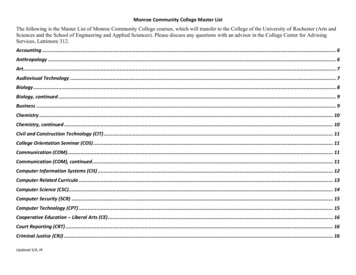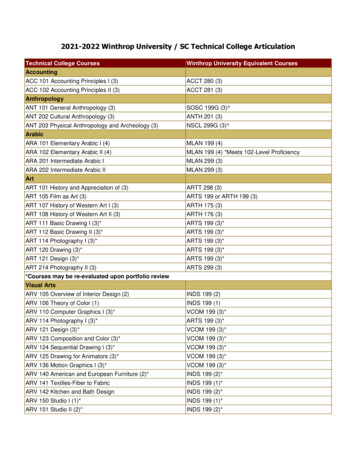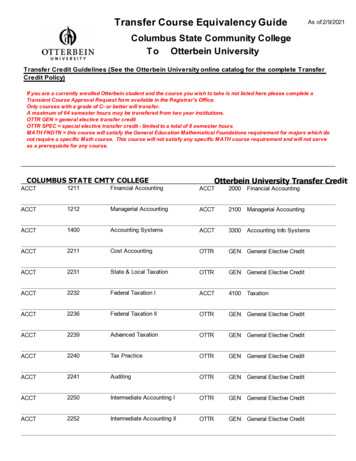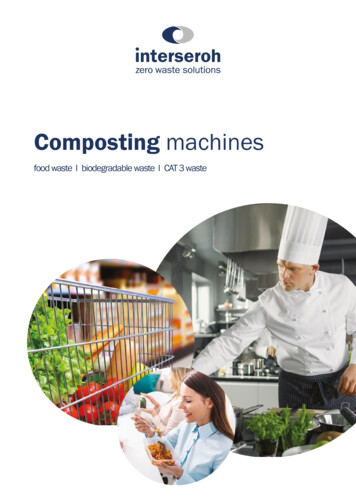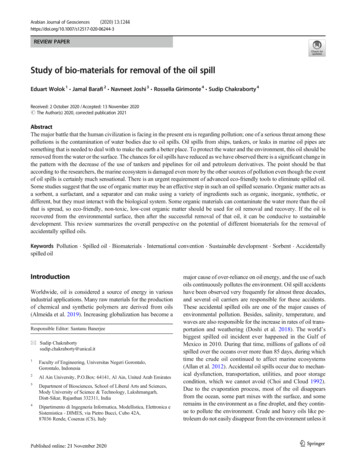
Transcription
Arabian Journal of Geosciences(2020) EVIEW PAPERStudy of bio-materials for removal of the oil spillEduart Wolok 1 & Jamal Barafi 2 & Navneet Joshi 3 & Rossella Girimonte 4 & Sudip Chakraborty 4Received: 2 October 2020 / Accepted: 13 November 2020# The Author(s) 2020, corrected publication 2021AbstractThe major battle that the human civilization is facing in the present era is regarding pollution; one of a serious threat among thesepollutions is the contamination of water bodies due to oil spills. Oil spills from ships, tankers, or leaks in marine oil pipes aresomething that is needed to deal with to make the earth a better place. To protect the water and the environment, this oil should beremoved from the water or the surface. The chances for oil spills have reduced as we have observed there is a significant change inthe pattern with the decrease of the use of tankers and pipelines for oil and petroleum derivatives. The point should be thataccording to the researchers, the marine ecosystem is damaged even more by the other sources of pollution even though the eventof oil spills is certainly much sensational. There is an urgent requirement of advanced eco-friendly tools to eliminate spilled oil.Some studies suggest that the use of organic matter may be an effective step in such an oil spilled scenario. Organic matter acts asa sorbent, a surfactant, and a separator and can make using a variety of ingredients such as organic, inorganic, synthetic, ordifferent, but they must interact with the biological system. Some organic materials can contaminate the water more than the oilthat is spread, so eco-friendly, non-toxic, low-cost organic matter should be used for oil removal and recovery. If the oil isrecovered from the environmental surface, then after the successful removal of that oil, it can be conducive to sustainabledevelopment. This review summarizes the overall perspective on the potential of different biomaterials for the removal ofaccidentally spilled oils.Keywords Pollution . Spilled oil . Biomaterials . International convention . Sustainable development . Sorbent . Accidentallyspilled oilIntroductionWorldwide, oil is considered a source of energy in variousindustrial applications. Many raw materials for the productionof chemical and synthetic polymers are derived from oils(Almeida et al. 2019). Increasing globalization has become aResponsible Editor: Santanu Banerjee* Sudip Chakrabortysudip.chakraborty@unical.it1Faculty of Engineering, Universitas Negeri Gorontalo,Gorontalo, Indonesia2Al Ain University, P.O.Box: 64141, Al Ain, United Arab Emirates3Department of Biosciences, School of Liberal Arts and Sciences,Mody University of Science & Technology, Lakshmangarh,Distt-Sikar, Rajasthan 332311, India4Dipartimento di Ingegneria Informatica, Modellistica, Elettronica eSistemistica - DIMES, via Pietro Bucci, Cubo 42A,87036 Rende, Cosenza (CS), Italymajor cause of over-reliance on oil energy, and the use of suchoils continuously pollutes the environment. Oil spill accidentshave been observed very frequently for almost three decades,and several oil carriers are responsible for these accidents.These accidental spilled oils are one of the major causes ofenvironmental pollution. Besides, salinity, temperature, andwaves are also responsible for the increase in rates of oil transportation and weathering (Doshi et al. 2018). The world’sbiggest spilled oil incident ever happened in the Gulf ofMexico in 2010. During that time, millions of gallons of oilspilled over the oceans over more than 85 days, during whichtime the crude oil continued to affect marine ecosystems(Allan et al. 2012). Accidental oil spills occur due to mechanical dysfunction, transportation, utilities, and poor storagecondition, which we cannot avoid (Choi and Cloud 1992).Due to the evaporation process, most of the oil disappearsfrom the ocean, some part mixes with the surface, and someremains in the environment as a fine droplet, and they continue to pollute the environment. Crude and heavy oils like petroleum do not easily disappear from the environment unless it
1244 Page 2 of 11is removed by a proper method and that oil can lead to dangerous situations (Choi and Cloud 1992; Ivshina et al. 2015a;EPA 2016; Joye 2015; Wu et al. 2014; Broje and Keller2007). Effective eco-friendly materials or technologies areneeded to remove and recover oil from the surface of theenvironment to protect it, especially the aquatic environment,from the harmful effects of oil spills; otherwise, marine ecosystems are likely to be severely damaged. The introduction ofan eco-friendly and sustainable initiative has led to the production of non-toxic, biodegradable materials along with different types of biomasses at cheaper prices for the purpose ofintroducing micro- to nano-sized materials, membranes,aerogel or sponges, etc. to recover and remove oil from waterresources (Fingas 2012). Among the most notorious oil spillsin history is the Deepwater Horizon in 2010. The incidentoccurred in the Gulf of Mexico and is considered the largestmarine oil spill. In response to addressing the spill to protectlocal flora and fauna, experimental materials were in wideapplication, some which had not been approved for usage bythe Environmental Protection Agency (EPA) to respond to oilspills (Ivshina et al. 2015a). There is an adverse health effectof spilled oil in the human body. Moderate to severe breathingtrouble, eye, skin irritation, etc. may be experienced. Fromtime to time, many scholars and researchers have altered theirnotion of the characteristics and influence of these oil spills onthe marine ecosystem (Henkel et al. 2012; Chang et al. 2014a)and modified different types of methods and chemicals whichare responsible for the oil spill (ITOPF Response Techniques2014). The kinds of clean-up technologies are to be applieddetermined by the location and spill intensity (Henkel et al.2012; Chang et al. 2014a; ITOPF Response Techniques2014).Based in the US, many other agencies have been in collaborative efforts with the United Nations to establish guidelinesin the use of certain materials with the potential to alter thenatural setting of communities. Following the widely criticizedexperimental oil spill removal, the EPA conducted an analysison some of the dispersants used in the removal of the spill andhave the following recommendations: firstly, the federal government of the affected region has the right to discontinue theuse of any dispersant should it be proved to have negativeconsequences. Secondly, dispersants used must apply the subsea application process, and finally, the coast guard is responsible for approving the use of dispersant from the NCP ProductSchedule. Later studies disapproved the use of dispersants inoil spill removal on grounds of increasing toxicity levels on theocean. In 2010, EPA gave a directive to reduce the use ofCorexit EC9500A and Corexit EC9527A dispersant by up to75%. Environmental regulation on the use of chemicals todisperse oil spills has led to focus drawn to more sustainableproducts like biosurfactants. However, the production of thesesubstances is relatively expensive and is used minimally tocontain oil spills in regions with high life (Fingas 2012).Arab J Geosci(2020) 13:1244There are international rules to deal with the issue of oilspills. For example, there is the Stockholm Declaration of1972 on the Human Environment (EPA Oil Spill ResponseTechniques 2017). It gives states an obligation to put in placemeasures to prevent pollution of ocean waters. This obligationto states is stated in principle 7, in which all member states arerequired to institute mechanisms to prevent pollution and theconsequential harm to human health, as well as other livingorganisms the most affected being animals that live in oceansand seas. The Stockholm Declaration of 1972 on the HumanEnvironment (EPA Oil Spill Response Techniques 2017) inits principle 22 specifically addresses the issue of liability onceoil spills occur in oceans and provides under international lawfor tackling the same. It also makes suggestions on the meansof tackling pollution through environmental-friendly means.There are also regional conventions such as the Helsinkiconvention which addresses more concepts, one of them beingprecautionary the best environmental practice. In line withthis, there are various ways in which oil spills are removed.Their duration will vary depending on the type and amount ofoil spill. Due to the higher density of the water than that of oil,the latter floats on the water. Its removal is therefore easierthan in a case where it does sink instead of float. One of theways for removing such spills is by using biomaterials. Thisentails the use of microorganisms that breakdown the oil spillsand other wastes into less toxic substances. Even though it isone of the cheapest methods, it has limitations. It cannot beused in deep seas. Also, the use of microorganisms encourages the growth of vegetation in the oceans. This will hurt theanimals living there.By the use of a chemical method, in situ burning, bioremediation, and a mechanical method, it can provide an excellentresult of spilled oil removal from the surface of the environment (Choi and Cloud 1992; Ivshina et al. 2015a; EPA 2016;Joye 2015; Wu et al. 2014; Broje and Keller 2007). However,studies have shown that mechanical and chemical methods arenot widely used due to their high cost and ineffective oil removal capacity (Alaa El-Din et al. 2018). Management ofthese wastes and later cleanup have necessitated the development of technologies to conduct the cleaning. The best available technologies today include chemical treatment, gravityseparation cyclone separation, and granular filtration.Despite all these technologies, biomaterials can be used toremove oil from the surface of the water. Biomaterials recoveremulsified oil based on their absorption capacity. There are noadverse effects on the environment, and biomaterials are considered to be a suitable method of oil extraction for low-costand high-quality extraction (Yati et al. 2016). Biomaterialshave some beneficial properties such as hydrophobic andoleophilic nature and high adsorption capacity; they are biodegradable, environment friendly, and leaves no harmful residue after the process (Asadpour et al. 2016). It should benoted that environmental conditions will vary the performance
Arab J Geosci(2020) 13:1244of the applied biomaterial method, in addition to cost-efficiency. Most of the methods used in removing oil spillage are new,and there are limited international laws governing its usage.The rate of oil removal from the environment depends onvarious factors such as the type of oil, their volatile nature,the amount of oil spillage, the geographical nature, and thepresence of biological communities (oil-eating germs)(Schrope 2011a; Wilson et al. 2017; Dicks 1999). Over thepast few years, there has been a need to develop organic materials for efficient oil removal, so research has focused onunderstanding some of the bio-materials, such as lotus leavesand beetles, and the mechanism behind their hydrophobic,oleophilic nature, and super-wettable surface (Feng et al.2002). Several surface modification techniques areunderstudied, and this research assumed that by using newsurface modification techniques, the process cost of oil removal can be reduced manyfold by using substrates like biomaterials and paper waste (Carmody et al. 2007; Sarkar andMahapatra 2014; Korhonen et al. 2011). This review sums upthe overall view on the environment-friendly biomaterials foroil spill management and the capability of absorbing the oil inthe form of absorbent, separator, and surfactants. Globally, tohandle the oil spill incident, different biomaterials are extensively studied because each biomaterial cannot be suitable inall kinds of oil spill scenarios. The importance of this review isto evaluate the adsorption capacity of different biomaterialsfor oil spill management along with their strengths andweaknesses.MethodAs discussed earlier, spilled oil must be removed from theenvironment; otherwise, the environmental surface gets polluted, and due to this, along with human civilization, differentanimal species might face the consequences. Before knowingthe beneficial aspect of biomaterials in oil spill management,three methods are widely used for the recovery of oil from thesurface of the environment (Fig. 1). Different types of oil spilltreatment methods are grouped as physical/mechanical, chemical, or biological (EPA 2017). Mobile floating devices suchas booms fall under physical and mechanical kinds whichaddress the oil spills and aid in stopping their movement.High-temperature booms usage can burn the oil spill on thesite itself (IOGP 2016). On the contrary, removal of floating oremulsified oil from the water and the surface is done by skimmers of stationary nature (Fingas 2012). Another method, adifferent technology named hydrophobic meshes, can be alsoused for the removal of an oil spill. The work of mesh is toallow the pass-through of oil by rejecting water flow (Grahamet al. 2016b; NOAA 2017). An oil spill can be broken intosmall droplets by using chemical spraying methods, and forsmall-scale oil spills, sorbent materials may be used. NowPage 3 of 11 1244Fig. 1 Process of spilled oil removal from the environmental surface(Ivshina et al. 2015b; Schrope 2011b; Graham et al. 2016a; Walther2014; Oil Tanker Spill Statistics 2018; Chang et al. 2014b)comes the biological method, several of which incorporatemicrobes and oxygen stimulants for bacterial growth and theculmination of biodegradation of the spilled oil (Azubuikeet al. 2016), whereas physiochemical methods are limited tocrude oil clean up (Das and Preethy 2011; Gupta and Tai2016).Spilled oil can be recovered through various processes, buteach of these did not have the equal ability to recover it. In theuse of different chemicals to coagulate the oil and in the formof dispersant, this chemical removes the oil from the ocean.Despite having a decent result, this chemical process did notfollow too much because this chemical component may beharmful to marine animals and can pollute the marine ecosystem (Goodbody-Gringley et al. 2013). Although it is the simplest and widely used technique to remove oil from the ocean,this process can emit a huge amount of dangerous smoke andthis leads to environmental pollution (Evans et al. 2001). Themost intensive-labor method for oil recovery is the mechanicalmethod. This is a technique where the absorbent material absorbs the oil. This technology uses a net-like structure which ismade up of absorbent material which basically encircled thepool of spilled oil and slowly shift to collect the oil from thesurface (Chang et al. 2014c; Barry et al. 2017). It should benoted that the sorbent is essentially chemically and mechanically stable, for the treatment of the oil spill, in addition toenvironment-friendly, recyclable, low density, and impressivebuoyancy properties (Gupta and Tai 2016).Due to the chances of polluting the environment, high cost,less adsorption capacity, the physical and chemical methodsare not used in any kind of oil spill scenario. So as an alternative method, biodegradable cheap biomaterials are widelyused for the removal of spilled oil from the surface.Different types of biomaterials are extensively used globallyas discussed below. As shown in Table 1, the natural products,kapok, rice straw, cotton, etc. are available abundantly, costeffective, biodegradable, and non-toxic and can be consideredideal as oil absorbents in oil-spill treatment.Biomaterials which act like sorbents are mostly used forsmall-scale oil spilled scenario. A good oil sorbent material
1244 Page 4 of 11Table 1Arab J GeosciBiomass-based sorbent used for the degradation and removal of oils (Ben and Kallel 2019; Tijani et al. 2016)MethodOilsSorbentWhite ash (Pyrolysis)DieselCrude oilDieselCrude oilGasolineDieselLight crude oilMotor oilHeavy crude oilMarine dieselMotor oilVegetable oilCrude oilWaste lubricating oilDiesel oilHeavy crude oilMineral oilVegetable oilCutting oilMineral oilVegetable oilCutting oilRice husksBlack ash (pyrolysis under N2)Pyrolysis at 480 CAlkaline treatmentDrying (110 C), cutting, and millingDrying (sunlight and 70 C), crushing, and sievingDrying (70 C) and crushingCutting, sieving, washing, and drying (105 )Shaking flask method, autoclave, and dryingHybridization of peels with NaOH and drying at 70 CMedia(2020) 13:1244Lubricant oilPetrol oilMineral oilVegetable oilDoALL Bright-Edge Oilshould have high adsorption ability and hydrophobic andoleophilic property, must ensure biodegradability, and shouldbe reused again. These properties of biomaterials make themdifferent in comparison with all other methods and techniques(Abdullah et al. 2010a; Adebajo et al. 2003). Natural sorbentbiomaterials have a high oil removal rate and also do not harmthe environment during the oil recovery process. According tothe studies, some of the plants show a high affinity for oil. Thisis because this type of plants has wax in their body. This waxystructure makes them able to float in the water (Gupta et al.2015; Al-Majed et al. 2012). Barley, oats, wheat, rice straw,and rice husk all come under organic sorbent biomaterials asmentioned above Table 1. These organic sorbents have higheradsorption capacity like advantages as well as some disadvantages such as they can absorb water during the oil removalprocess if the oil is present in an aqueous medium. Researchhas shown that some of the biomaterials described above havehigher absorption capacity than others. For example, Kapokfiber, raw cotton, chitosan, and Chorisia speciosa. The higheroleophilic nature of Kapok fiber (20–50 g/g) or the cotton afteracetylation of cellulose gives them a higher affinity towardsRice husksRice husksRice husksSilkworm cocoon wasteBanana skinsBanana skinsLuffa (an agricultural waste)M. rouxii (32.7% chitosan)A. coerulea (10.4% chitosan)Hybrid peel waste (banana skins orange peel)Hybrid peel waste (banana skins orange peel)oil and helps the biomaterial for efficiently removing the spilledoil (Choi et al. 1993; Choi and Moreau 1993; Lim and Huang2007; Deschamps et al. 2003). Normal raw cotton can also remove the oil from the surface, but after the acetylation process,the cotton becomes more stable and biodegradable. The Chorisiaspeciosa shows the highest oil adsorption ability among all thebiomaterials. In wet conditions, the Chorisia speciosa has lessaffinity towards the water as compared to all other biomaterialsand that is why it is used for a more efficient oil removal process.Research has shown that due to high hydrophobicity andoleophilic nature, the Chorisia speciosa fiber can adsorb up to85 g of oil per gram of adsorbent in 1 day (Amico 2010).Chitosan can be used as an oil-removing biomaterial. It is adifferent form of chitin which is found in the body of manyaquatic animals. Structurally, it is a charge bipolymer having agood attraction towards the opposite charge if it is present inthe oil-water mixture. Chitosan is a polysaccharide containingN-acetyl-D-glucosamine residue in its C2 position, and thiscomposed structure is responsible for the electrostatic interaction between chitosan and oil-water emulsion, hence behaveas an emulsifier (Aranaz et al. 2010). Chitosan is derived from
Arab J Geosci(2020) 13:1244chitin, and after a chemical and physical modification of thestructure, it can become more soluble in water than before, andin this, the modified form is used in a different type of industryfor the removal of contaminant from water (Pintor et al. 2016;Kyzas and Bikiaris 2015). Chemically hydrophobicity moieties can be added in a chitosan structure, and this helps to formmore stable amphiphilic chitosan (Lü et al. 2015). Recentstudies have shown that biomaterials such as chitosan in theform of aerogel might be found in seafood waste.Kapok is a type of natural fiber which has excellent oilremoving capacity from the surface. It has a good amount ofoil adsorption capacity due to the porous nature of this fiber andthe waxy coating on their structure (Wang et al. 2012). Severalsurface modification techniques such as acetylation and esterification are used to increase the amount of oil adsorbed. Kapokfiber has a large number of the hydroxyl group in their nativestructure, and this is the main reason behind the limited oilsorption ability. However, this structure can be modified tocreate a superhydrophobic and oleophilic surface.Cotton is also used for the sorption of crude oil from thesurface. Cotton is cheap, is biodegradable, has good oil retention capacity, and can be reutilized again. All these propertiesof cotton make it a better choice for the oil removal process.Low micronaire cotton is referred to immature cotton fiberwhich is mostly used for oil recovery because they havehigher wax content and fine fiber on their structure (Cuiet al. 2002). If the cotton fiber has a high amount of cellulosedeposition, that means the fiber is mature enough and it canadsorb less amount of oil. The linear density of the fiber alsoaffects the oil recovery capacity (Montalvo Jr. 2005). Studiessuggested that low micronaire cotton can adsorb more oil thannormal cotton and it is economically valuable.Like India or China, there are many countries in the worldwhere rice is produced and served as the main source of food.Statistics show that globally, more than 600 million tons ofrice is produced and one-fourth of that represents the rice huskmade each year worldwide (Chandrasekhar et al. 2003).Actually, rice husk is an agricultural waste, but the presenceof cellulose in its cell wall pulled the attention of the researchers. Some researchers have shown that rice husk canbe used as an oil sorbent biomaterial due to the presence ofcellulose in its cell walls. To reduce the environmental pollution caused by other types of oil-removing method, rice huskand rice straw are widely used for the oil spill treatment asshown in Fig. 2 (Hu and Hsieh 2014). About 30% of celluloseis present in the rice husk structure before to be extracted fromthe raw rice husk, and then, different modification techniquesare used to achieve super-hydrophobicity and high celluloseconcentration. Biodegradable property and high adsorptioncapacity make rice husk one of the most important biomaterials used for the oil removal process.Walnut shells as a separant agent have shown a promisingresult for oil removal from the water. Walnut shells havePage 5 of 11 1244selectivity to separate oily pollutants from the water, and thatis why it is used on the filtration process. Due to their porousnature, they show different sorption capability towards thedifferent medium. Studies have shown that viscous oil medium generally takes more time to adsorbed through the porouswalnut shell, but they can effectively separate oil from theaqueous medium (Srinivasan and Viraraghavan 2010;Srinivasan and Viraraghavan 2008). Sometimes carbon fiberis used for the removal of heavy oil. Because of havingsmooth surface morphological characteristics and a high sorption rate of oil, carbon fiber shows almost 100% removal ofoil. Then, the adsorbed oil can be recovered from the carbonfiber by doing centrifugation for a few minutes (Inagaki et al.2002).Apart from the abovementioned biomaterials, barley straw,sawdust, cross-link cellulose, and oat straw are also used forthe oil removal process. By using these biomaterials, one canalso efficiently remove oil from the surface. So sorbents andsurfactants which are used in the oil removal process musthave good hydrophobicity and oleophilic nature, oil retentiontime, selectivity, good recovery rate, cheap, eco-friendly, donot cause any pollution; also, they should be biodegradable.We have observed that two things happen during the processof removal of an oil spill. Firstly, spilled oil is left for biodegradation which is a natural and time taking procedure.Secondly, it can be removed from the environment by theapplication of various biodegrading agents and the operationof different technical and mechanical methods.Effect of parametric trend in oil spill removalParticlesA particle characterized by its size and porosity is the basis ofparticle mannerism of oil and water. Two types of classifications such as dispersed phase (oil) and continuous phase(aqueous/water) under small volume fraction and large volume cover up the emulsion system. Now, throwing light onstrong hydrophilic particles and strong hydrophobic particles,the former get wetted only by water, and emulsion takes on anaqueous phase of dispersed particles, whereas the latter getwetted only by the oil and remain in that phase. Raw naturalsorbents have low hydrophobicity which degrades oil sorptionability by increasing water uptake, but in a general sense, thesesorbents are known for their incredible adsorption capacity,biodegradability, and non-toxicity when compared with synthetic sorbents. Nanoparticles and polymer-based blends aregoing higher up on the scale as its surface functionality andbiodegradability are user friendly for removing oil alongsideproviding reusing facility and simple recovery (Fouad et al.2016). If we now focus on smaller particles (5 nm–52 μm)(Lam et al. 2014), these are capable of getting absorbed at theoil-water interface, specifying wetness by both water and oil,
1244 Page 6 of 11Arab J Geosci(2020) 13:1244Fig. 2 Oil spill treatment methodsbased on oil recovery or oildispersionso these Pickering emulsions help in stabilizing emulsions. Allthese criteria need not be satisfied by particulate adsorbents asthe aqueous phase cannot wet oil adsorbents, and so normally,they depend on hydrophobic preparation. Adsorbent particlesare famous for their surface roughness and porosity resultingin an increased surface area of the absorbent. Pickering emulsions’ (Lam et al. 2014) stability deteriorates with surfaceroughness and is not under desirable phenomena. The aboveparticles mentioned can be various, acting as a surfactant,dispersing agent, emulsifying agent, herding agent, or coatingmaterials. Table 2 signifies the various roles in the adsorptionof oils.Commonly used adsorbentsIn recent years, due to the pollution caused by mechanical andchemical methods, biomaterials are widely used for the recovery of oil from the surface. Biomaterials are biodegradable,pollution-free, and cheap. Nowadays, research is going on thedevelopment of novel synthetic biomaterials which can workas a sorbent and can be efficiently used as the removing agentof oil. One biomaterial cannot be used in all kinds of oil spillscenarios because different biomaterials and different oilshave their different characteristics. Some of the biomaterialscan effectively remove oil at low pH, and some of them mayeffortlessly work at a different environmental condition. Thereare various oil removal methods reported in this paper (seeTable 3), such as distillation, vacuum filtration, andextraction.Chitosan is the most important oil-removing biomaterial asmentioned above. Normally, chitosan having a pH of 6.8,moisture content 2.8%, a porosity of 60–65%, and a degreeof de-acetylation higher than 85% (Chi and Cheng 2006).Studies have shown that chitosan has a better oil removal rateat low pH (pH 5), up to 99%. The reason is that at this pHlevel, the zeta potential value which refers to the oil stability inthe water is low. When the pH is increased, then the zetapotential value also increases which means the stability ofoil in water is so high that greater force is required to separatethe oil from water (Reynolds and Richards 1995). In this situation where the zeta potential value of the emulsion is high,then the removal of oil will become very difficult for thebiomaterial. As the pH is increased (pH 7), the oil removalrate also decreased. Acidic pH helps the adsorption processand catalyzed the reaction to help the oil droplet to fit in theactive site on the chitosan molecule (Ahmad et al. 2005).Chitosan can absorb up to 99.9 mg/g of oil from the oil.Among the fungal biomasses, Mucor rouxii exhibits oil adsorption capacity up to 90% and researchers thought that thishigher amount of oil removal rate is achieved due to the presence of chitosan in their cell walls (Yan and Viraraghavan2000).Figure 3 explains how different pH affects the chitosanadsorption rate. As time increases, the adsorption also increases until at one time the rate becomes constant. Thehighest adsorption rate achieved at 5 pH is 99.9%. If the pHof the surface is high, then the adsorption rate will decrease asthe above graph has shown. Studies have shown that 191 kg ofchitosan is required to remove 99% of oil from the 100 m3 oilywater.Along with chitosan, Kapok fiber is also widely used for oilremoval. Studies demonstrated the structure of Kapok fiberand its state as seen in the scanning electron microscope,and the porous structure of the fiber is responsible for the highadsorption rate (Dong et al. 2014). The Kapok fiber is hydrophobic in nature so it has a high affinity towards oil thanwater, so in the aqueous medium, the fiber tends to adsorbedoil. Since having a high water contact angle, Kapok fibershows this super-hydrophobicity and oleophilic nature. Theresearch suggested that its waxy structure may be responsiblefor the high water contact angle in Kapok fiber. Higher staticcontact angle and higher interfacial energy barriers betweenKapok fiber and oil are also responsible for the slow oilspreading on the fiber. This is the reason behind the long
Arab J GeosciTable 2(2020) 13:1244Page 7 of 11 1244Different particles used in the formation of emulsions, removal, and recovery of oilsParticlesMethodOilChitinChitosanChitosanPowder formTolueneGrafting using free radical polymerizationGasoilMobil-1 oilLight crud
handle the oil spill incident, different biomaterials are exten-sively studied because each biomaterial cannot be suitable in iewis to evaluate the adsorption capacity of different biomaterials for oil spill management along with their strengths and weaknesses. Method
